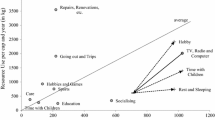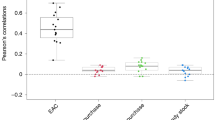Abstract
This study examines how working hours and the opportunity cost of time affect an individual’s decision to participate in a time-consuming pro-environmental activity—namely, the purchase of refillable products—while using data from the Japanese General Social Survey 2002. By purchasing refillable products, an individual can reduce the amount of waste that needs to be disposed; however, she or he must spend time refilling bottles (i.e., a pro-environmental activity). Our empirical results demonstrate that individuals who work long hours and those with high wage rates tend to purchase nonrefillable products. Therefore, both time constraints and the opportunity cost of time are important factors in the decision to undertake pro-environmental activities.
Similar content being viewed by others
Notes
A majority of previous studies have found that women are more active than men in terms of participation in pro-environmental activities (Schultz et al. 1995; Sidique et al. 2010). Further, well-educated people are more cooperative than less-educated ones (Derksen and Gartrell 1993; Owens et al. 2000). However, the effect of age varies according to the type of pro-environmental activity (Sterner and Bartelings 1999). Finally, numerous studies find a positive relationship between income level and pro-environmental activities (Kotchen and Moore 2007; Oskamp et al. 1991; Welsch and Kühling 2009).
Most studies have ignored the labor force participation decisions of individuals and treat income as an exogenous variable. They then evaluated an income effect on pro-environmental behavior. This approach may change the results of the analysis of the sociodemographic variables; since the results influence the labor force participation decision, ignoring this decision will lead to either an overestimation or underestimation of their effects on pro-environmental behavior.
Matsumoto (2011) examined how the working conditions of local residents affect municipal recycling programs. He found that the number of working hours of the average resident explained the complexity of the recycling program.
Hong and Adams (1993) assumed that the opportunity cost of time was zero for households headed by a retired person.
JGSS studies 12 pro-environmental activities popular among Japanese people: (1) energy-saving practices, (2) water-saving practices, (3) the repair and use broken items, (4) recycled product purchase, (5) refillable product purchase, (6) organic vegetable purchase, (7) bring own shopping bag, (8) ask for plain wrapping, (9) purchase products from recycled-goods shops, (10) use public transportation, (11) properly separate garbage, and (12) compost kitchen garbage. Time is not an important factor in undertaking some of these activities, such as (6) organic vegetable purchase. Response variation in other activities—such as (11) properly separate waste—was too small for the empirical analysis. Thus, in the current study, we decided to analyze refillable product purchase.
The income is censored at 23 million yen; we set the highest income at 25 million yen. The percentage of households within this category is 0.57 %.
A detailed discussion is provided in Appendix B.
We computed an individual’s gross wage rate on the basis of his or her household income information.
To examine the validity of the inclusion of two motivation variables (crowding-out effect and warm-glow motivation), we applied exogeneity tests for simultaneous equations models that comprise pro-environmental activity and motivation equations. Then we tested the independence between error terms. The t-ratios of the covariance terms were quite close to zero. Thus, we used the motivation variable as the exogenous variable in this study. We thank an anonymous referee for addressing this point.
References
Ando, A. W., & Gosselin, A. Y. (2005). Recycling in multifamily dwellings: Does convenience matter? Economic Inquiry, 43, 426–438. doi:10.1093/ei/cbi029.
Andreoni, J. (1990). Impure altruism and donations to public goods: A theory of warm-glow giving. Economic Journal, 100, 467–477. doi:10.2307/2234133.
Becker, G. (1965). A theory of the allocation of time. Economic Journal, 75, 493–517. doi:10.2307/2228949.
Berglund, C. (2006). The assessment of households’ recycling costs: The role of personal motives. Ecological Economics, 56, 560–569. doi:10.1016/j.ecolecon.2005.03.005.
Bjørner, T. B., Hansen, L. G., & Russell, C. S. (2004). Environmental labeling and consumers’ choice: An empirical analysis of the effect of the Nordic swan. Journal of Environmental Economics and Management, 47, 411–434. doi:10.1016/j.jeem.2003.06.002.
Brown, E., & Lankford, H. (1992). Gifts of money and gifts of time: Estimating the effects of tax prices and available time. Journal of Public Economics, 47, 321–341. doi:10.1016/0047-2727(92)90032-B.
Bruvoll, A., Halvorsen, B., & Nyborg, K. (2002). Households’ recycling efforts. Resources, Conservation and Recycling, 36, 337–354. doi:10.1016/S0921-3449(02)00055-1.
Bruvoll, A., & Nyborg, K. (2004). The cold shiver of not giving enough: On the social cost of recycling campaigns. Land Economics, 80, 539–549. doi:10.2307/3655809.
Bunkyo-ku. (2008). A survey about waste and recycling in Bunkyo ward. (In Japanese).
Cabinet Office, Government of Japan. (2005). National lifestyle monitor survey 2004 (opinion survey on environmental problems). Retrieved October 8, 2012, from http://www.caa.go.jp/seikatsu/monitor/h1603monitor.pdf.
Carlin, P. S. (2001). Evidence on the volunteer labor supply of married women. Southern Journal of Economics, 67, 801–824. doi:10.2307/1061572.
Derksen, L., & Gartrell, J. (1993). The social context of recycling. American Sociological Review, 58, 434–442. doi:10.2307/2095910.
Fuess, S. M. (2012). Leisure in Japan, 1986–2006: A revival? Journal of Family and Economic Issues, 33, 250–260. doi:10.1007/s10834-012-9305-4.
Geweke, J. F., Keane, M. P., & Runkle, D. (1994). Alternative computational approaches to inference in the multinominal probit model. Review of Economics and Statistics, 76, 675–695. doi:10.2307/2109766.
Gronau, R. (1980). Home production—a forgotten industry. Review of Economics and Statistics, 62, 408–416. doi:10.2307/1927108.
Halvorsen, B. (2008). Effects of norms and opportunity cost of time on household recycling. Land Economics, 84, 501–516. doi:10.3368/le.84.3.501.
Hong, S., & Adams, R. M. (1993). An economic analysis of household recycling of solid wastes: The case of Portland, Oregon. Journal of Environmental Economics and Management, 25, 136–146. doi:10.1006/jeem.1993.1038.
Hoynes, H. W. (1996). Welfare transfers in two-parent families: Labor supply and welfare participation under AFDC-UP. Econometrica, 64, 295–332. doi:10.2307/2171784.
Jakus, P. M., Tiller, K. H., & Park, W. M. (1996). Generation of recyclables by rural households. Journal of Agricultural and Resource Economics, 21(1), 96–108.
Japanese General Social Survey. (2002). Social science Japan archive. Retrieved July 26, 2010, from https://ssjda.iss.u-tokyo.ac.jp/Direct/?lang=eng.
Kahneman, D., & Knetsch, J. (1992). Valuing public goods: The purchase of moral satisfaction. Journal of Environmental Economics and Management, 22, 57–70. doi:10.1016/0095-0696(92)90019-S.
Kim, S., Yeo, J., Sohn, S. H., Rha, J., Choi, S., Choi, A., et al. (2012). Toward a composite measure of green consumption: An explanatory study using a Korean sample. Journal of Family and Economic Issues, 33, 199–214. doi:10.1007/s10834-012-9318-z.
Kinnaman, T. C. (2006). Policy watch: Examining the justification for residential recycling. Journal of Economic Perspectives, 20, 219–232. doi:10.1257/jep.20.4.219.
Kooreman, P., & Wunderink, S. (1996). The economics of household behavior. New York: Macmillan Press Ltd.
Kotchen, M., & Moore, M. R. (2007). Private provision of environmental public goods: Household participation in green-electricity programs. Journal of Environmental Economics and Management, 53, 1–16. doi:10.1016/j.jeem.2006.06.003.
Matsumoto, S. (2011). Waste separation at home: Are Japanese municipal curbside recycling policies efficient? Resources, Conservation and Recycling, 55, 325–334. doi:10.1016/j.resconrec.2010.10.005.
Menchik, P., & Weisbrod, B. (1987). Volunteer labor supply. Journal of Public Economics, 32, 159–183. doi:10.1016/0047-2727(87)90010-7.
Morris, G. E., & Holthausen, D. M, Jr. (1994). The economics of household solid waste generation and disposal. Journal of Environmental Economics and Management, 26, 215–234. doi:10.1006/jeem.1994.1014.
Nunes, P. A. L. D., & Schokkaert, E. (2003). Identifying the warm glow effect in contingent valuation. Journal of Environmental Economics and Management, 45, 231–245. doi:10.1016/S0095-0696(02)00051-7.
Oskamp, S., Harrington, M. J., Edwards, T. C., Sherwood, D. L., Okuda, S. M., & Swanson, D. C. (1991). Factors influencing household recycling behavior. Environment and Behavior, 23, 494–519. doi:10.1177/0013916591234005.
Owens, J., Dickerson, S., & Macintosh, D. L. (2000). Demographic covariates of residential recycling efficiency. Environment and Behavior, 32, 637–650. doi:10.1177/00139160021972711.
Prowse, V. (2009). Estimating labour supply elasticities under rationing: A structural model of time allocation behavior. Canadian Journal of Economics, 42, 90–112. doi:10.1177/00139160021972711.
Saphores, J. D. M., Nixon, H., Ogunseitan, O. A., & Shapiro, A. A. (2006). Household willingness to recycle electronic waste: An application to California. Environment and Behavior, 38, 183–208. doi:10.1177/0013916505279045.
Schultz, P. W., Oskamp, S., & Mainieri, T. (1995). Who recycles and when: A review of personal and situational factors. Journal of Environmental Psychology, 15, 105–121. doi:10.1016/0272-4944(95)90019-5.
Sidique, S. F., Lupi, F., & Joshi, S. V. (2010). The effects of behavior and attitudes on drop-off recycling activities. Resources, Conservation and Recycling, 54, 163–170. doi:10.1016/j.resconrec.2009.07.012.
Sterner, T., & Bartelings, H. (1999). Household waste management in a Swedish municipality: Determinants of waste disposal, recycling and composting. Environmental & Resource Economics, 13(4), 473–491.
Tuttle, R., & Garr, M. (2012). Shift work and work to family fit: Does schedule control matter? Journal of Family and Economic Issues, 33, 261–271. doi:10.1007/s10834-012-9283-6.
Welsch, H., & Kühling, J. (2009). Determinants of pro-environmental consumption: The role of reference groups and routine behavior. Ecological Economics, 69, 166–176. doi:10.1016/j.ecolecon.2009.08.009.
Winkler, A. E., & Ireland, T. R. (2009). Time spent in household management: Evidence and implications. Journal of Family and Economic Issues, 30, 293–304. doi:10.1007/s10834-009-9160-0.
Yuda, M. (2007). An estimation of full price elasticity in the demand for outpatient medical services by the Japanese elderly. JCER Journal (Japan Center for Economic Research), 57, 23–52. (in Japanese).
Acknowledgments
This study was supported by the Asahi Glass Foundation and the Grant-in-Aid for Scientific Research (B) 21330056 from the Japan Society for the Promotion of Science. An earlier version of this paper was presented at the Biennial Pacific Rim Conference of the Western Economic Association International and Kobe University. We would like to express our gratitude to Akira Hibiki, Vincent Hoang, Yoshifusa Kitabatake, John Janmaat, Takayoshi Shinkuma, Toshiaki Sasao, Tetsuo Suwa, Tomohiro Tasaki, and Keiko Yamaguchi for their useful comments. The Japanese General Social Surveys (JGSS) are designed and carried out at the Institute of Regional Studies at Osaka University of Commerce in collaboration with the Institute of Social Science at the University of Tokyo under the direction of Ichiro Tanioka, Michio Nitta, Hiroki Sato, and Noriko Iwai with Project Manager, Minae Osawa. The project is financially assisted by Gakujutsu Frontier Grant from the Japanese Ministry of Education, Culture, Sports, Science and Technology for 1999–2003 academic years, and the datasets are compiled and distributed by SSJ Data Archive, Information Center for Social Science Research on Japan, Institute of Social Science, the University of Tokyo.
Author information
Authors and Affiliations
Corresponding author
Appendices
Appendix A. Estimation of Reservation Wage
From Eq. 5, we obtain
Using the latent variable, Eq. 7 can be expressed as
Assuming that the error terms were correlated with
we estimated the following log-likelihood function:
where I is the index. The first term is applied to the workers and the second to the non-workers.
Appendix B. Calculation of Hourly Wage
Japanese General Social Survey 2002 includes data pertaining to both annual labor income and total number of working hours in the previous week. We multiplied the total number of working hours in the previous week by 40, in order to obtain the annual number of working hours. Thereafter, we approximated the hourly wage by dividing the annual income by the total number of working hours in a year. However, the approximate hourly wage may include a measurement error. Therefore, as a robustness check, we also estimated the annual labor income. We did not consider the number of working hours; instead, we estimated the annual income that respondents or spouses expect to earn in the labor market. The results of the annual income model are based on this approach and are presented in Table 4.
Rights and permissions
About this article
Cite this article
Matsumoto, S. The Opportunity Cost of Pro-Environmental Activities: Spending Time to Promote the Environment. J Fam Econ Iss 35, 119–130 (2014). https://doi.org/10.1007/s10834-013-9354-3
Published:
Issue Date:
DOI: https://doi.org/10.1007/s10834-013-9354-3




